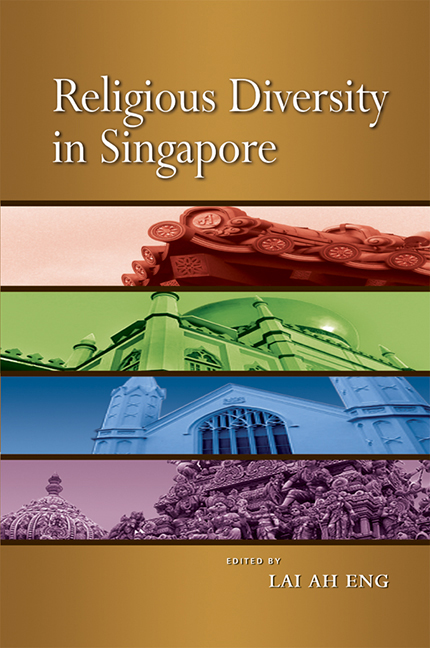Book contents
- Frontmatter
- Contents
- List of Figures and Tables
- List of Appendices
- FOREWORD
- PREFACE
- Acknowledgements
- The Contributors
- Abbreviations
- Glossary
- INTRODUCTION
- PART I The Landscape of Religious Diversity
- 1 Religious Influences and Impulses Impacting Singapore
- 2 Religious Trends and Issues in Singapore
- 3 Keeping God in Place: The Management of Religion in Singapore
- 4 Discourses on Islam in Southeast Asia and Their Impact on the Singapore Muslim Public
- 5 Global Christian Culture and the Antioch of Asia
- 6 “Religiously-inspired”, “India-derived” Movements in Singapore
- 7 Baha'is in Singapore: Patterns of Conversion
- 8 Diversities and Unities: Towards a Reformist Buddhism in Singapore
- 9 The Sathya Sai Baba Movement in Singapore: Its Service Mission and Philosophy of Communal Identity Construction
- 10 The Muslim Religious Elite of Singapore
- 11 The Evolution of the Sikh Identity in Singapore
- 12 Religious Processions: Urban Politics and Poetics
- PART II Religion in Schools and Among the Young
- PART III Religion in the Media
- PART IV Religious Organizations in Social Services
- PART V Interfaith Issues and Interaction
- Index
5 - Global Christian Culture and the Antioch of Asia
from PART I - The Landscape of Religious Diversity
Published online by Cambridge University Press: 21 October 2015
- Frontmatter
- Contents
- List of Figures and Tables
- List of Appendices
- FOREWORD
- PREFACE
- Acknowledgements
- The Contributors
- Abbreviations
- Glossary
- INTRODUCTION
- PART I The Landscape of Religious Diversity
- 1 Religious Influences and Impulses Impacting Singapore
- 2 Religious Trends and Issues in Singapore
- 3 Keeping God in Place: The Management of Religion in Singapore
- 4 Discourses on Islam in Southeast Asia and Their Impact on the Singapore Muslim Public
- 5 Global Christian Culture and the Antioch of Asia
- 6 “Religiously-inspired”, “India-derived” Movements in Singapore
- 7 Baha'is in Singapore: Patterns of Conversion
- 8 Diversities and Unities: Towards a Reformist Buddhism in Singapore
- 9 The Sathya Sai Baba Movement in Singapore: Its Service Mission and Philosophy of Communal Identity Construction
- 10 The Muslim Religious Elite of Singapore
- 11 The Evolution of the Sikh Identity in Singapore
- 12 Religious Processions: Urban Politics and Poetics
- PART II Religion in Schools and Among the Young
- PART III Religion in the Media
- PART IV Religious Organizations in Social Services
- PART V Interfaith Issues and Interaction
- Index
Summary
INTRODUCTION
As a network religion that spans the globe, evangelical Christianity is one of the most important social movements of the last two centuries. As a consequence of evangelism and missions, Christian communities exist in all parts of the world, and Christian leaders often pronounce their religion a universal brotherhood. But evangelical Christianity is highly diverse and plural, with networks that are multiple and overlapping.
The term “evangelical” does not describe any particular group or denomination, but rather tends to be applied to a variety of churches and organizations formed in the eighteenth century or later under the influence of widespread revivalist movements. As a religious movement, evangelical Christianity has changed over time, but nonetheless continues to have at its core a “remarkably constant” set of features (Bebbington 1989, p. 4). Scholars of evangelical Christianity commonly cite David Bebbington's formulation of these persistent features, which are: “conversionism, the belief that lives need to be changed; activism, the expression of the gospel in effort; Biblicism, a particular regard for the Bible; and what may be called crucicentrism, a stress on the sacrifice of Christ on the cross” (Bebbington 1989, p. 3). Mark Noll observes that these traits “have never by themselves yielded cohesive, institutionally compact, or clearly demarcated groups of Christians”, but they do identify “a large family of churches and religious enterprises” (Noll 2001, p. 13). One recent study estimates that out of two billion Christians in the world, 650 million are evangelical (Noll 2001, p. 278).
Evangelical Christians living in multi-cultural, post-modern North America and Europe are aware that attempts to convert others to their religion may cause offence or lead to the charge of intolerance. Indeed, some Christian theologians and historians now conclude that proselytism is based on absolutist assumptions of divine election that no longer have a place in a diverse, pluralistic world. Many Christians now participate in interdenominational and inter-religious dialogues, seeking to build unity rather than division, and theologians like Taiwanese Presbyterian Choan-Seng Song (1990 [1979]) have proposed alternatives to the exclusive Christian doctrine of salvation, emphasizing for example the development of an Asian theology contextualized in Asian philosophy and culture. But Song's views are not widely popular in Singapore, where most churches are evangelical and missionminded.
- Type
- Chapter
- Information
- Religious Diversity in Singapore , pp. 116 - 141Publisher: ISEAS–Yusof Ishak InstitutePrint publication year: 2008

